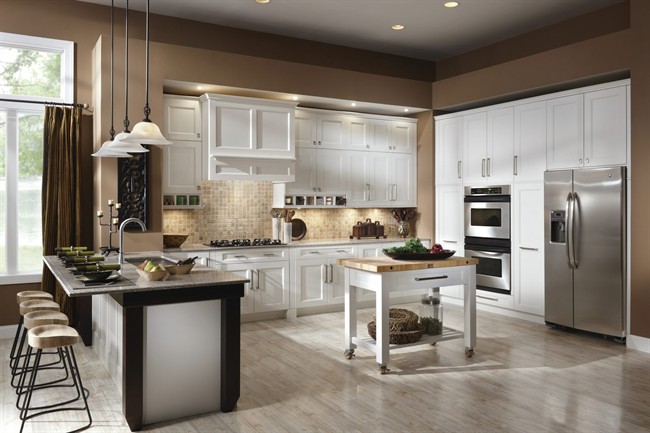Kitchens have always served as more than cooking and eating spaces. Generations of kids have done homework at kitchen tables. Parents claim counter space to organize family miscellany, tap out work emails on laptops or install a television.

But now those work and entertainment uses are part of kitchen design from the get-go.
The era of the “super kitchen” has arrived.
“Our findings show that homeowners expect kitchen renovations to go far beyond improving flow, storage or esthetics,” said Nino Sitchinava, principal economist at Houzz.com, in announcing the site’s 2016 Kitchen Trends Survey. “The ‘super kitchen’ has literally become a living room, family room and office, with finishes, layouts and decor that challenge us to define where the kitchen ends and the rest of the home begins.”
Interior designer Mikel Welch calls the kitchen “the new epicenter of the house.”
“Everybody’s working from home,” and they often prefer doing that in an open kitchen rather than a sequestered home office.
What are the features of a true “super kitchen”?
HIGH-TECH STATIONS
Designer Tiffany Brooks, host of HGTV‘s “Most Embarrassing Rooms in America,” says homeowners want technology within easy reach, but protected from food and drink spills. Some add a built-in iPad docking area or laptop station on a counter, while others choose the less expensive option of adding a tablet dock mounted under a cabinet, with an arm that swings out.

Get daily National news
People also want power. Pop-up outlets are being installed directly into countertops, says Sarah Fishburne, director of trend and design for the Home Depot. Wireless “charging countertops” are also available, including LG’s Tech Top and Dupont Corian. And homeowners are adding extra power outlets throughout the kitchen, and designing dedicated charging areas with power strips.
The goal, says Fishburne, is to have “many outlets readily available for anything you might need to plug in, from computer to glue gun.”
Another tech choice: Dishwashers that run almost silently, so they won’t distract you while you’re working in the kitchen. And full-size televisions are being added to the main cooking area so you can do your binge-watching in the same place where you try to avoid binge-eating.
The traditional focus of kitchen planning — a stove-sink-refrigerator triangle — has become a square, Welch says, with the TV added as a core necessity.
Occasionally, new kitchen technology does involve food: “Warming drawers are huge,” Brooks says. Because many people work nontraditional hours, “somebody is cooking at 2,” she says, “but then somebody is eating at 5, and somebody is coming home at 9.”
And some people, Welch says, “want to essentially bring Starbucks to them.” Restaurant-quality drink facilities are being added to home kitchens, including elaborate built-in tea and coffee stations, built-in soda systems, faucets with a sparkling water spigot and temperature-controlled wine refrigerators.
MORE SURFACES, MORE SEATING, MORE STORAGE
“An emerging trend is two islands being incorporated into a kitchen, if there is space,” says Fishburne.
“This allows for a prep island and an island to accommodate other family functions like work or homework while you are preparing dinner.”
Several of Welch’s design clients have requested oversize countertops that “allow six to eight people to comfortably sit with barstools,” he says.
Lounging-friendly seating is a priority, whether or not guests will be eating. If a kitchen doesn’t have space for a sectional sofa or other large seating, some homeowners are knocking down walls to merge the kitchen with other rooms. Houzz says half of its survey respondents reported making their kitchens more open to other indoor spaces.
READ MORE: How to declutter and get organized
And along with opening up the kitchen to the rest of the house, many homeowners are decorating the kitchen to match other rooms.
“The kitchen is becoming a lot prettier,” Brooks says.
“It is what the living room was” years ago.
The kitchen backsplash area can be a creative showcase, the designers say, using custom-made tiles or even antique mirrored glass.
Kitchen storage, too, is becoming more stylish and more organized. Closet-design systems originally conceived for bedroom closets are now being used to organize kitchen cabinets and pantries, Brooks says.
READ MORE: New ‘super pantry’ trend a secret weapon for kitchen decluttering
And rather than cramming work papers or family files into a cabinet designed for dishes, designers are building office and crafts storage into the kitchen. Many kitchens now have desks or computer workstations, and the days of bringing in “horrible, chunky rolling cabinets” to store files is over, says Welch. Non-kitchen items are stored in “built-ins that match the rest of the kitchen.”
Whether they’re asking for the most flattering lighting or details like high-end brass cabinet pulls, clients want everything to be beautiful, Welch says. More than ever, they want “that visual ‘wow’ factor.”





Comments